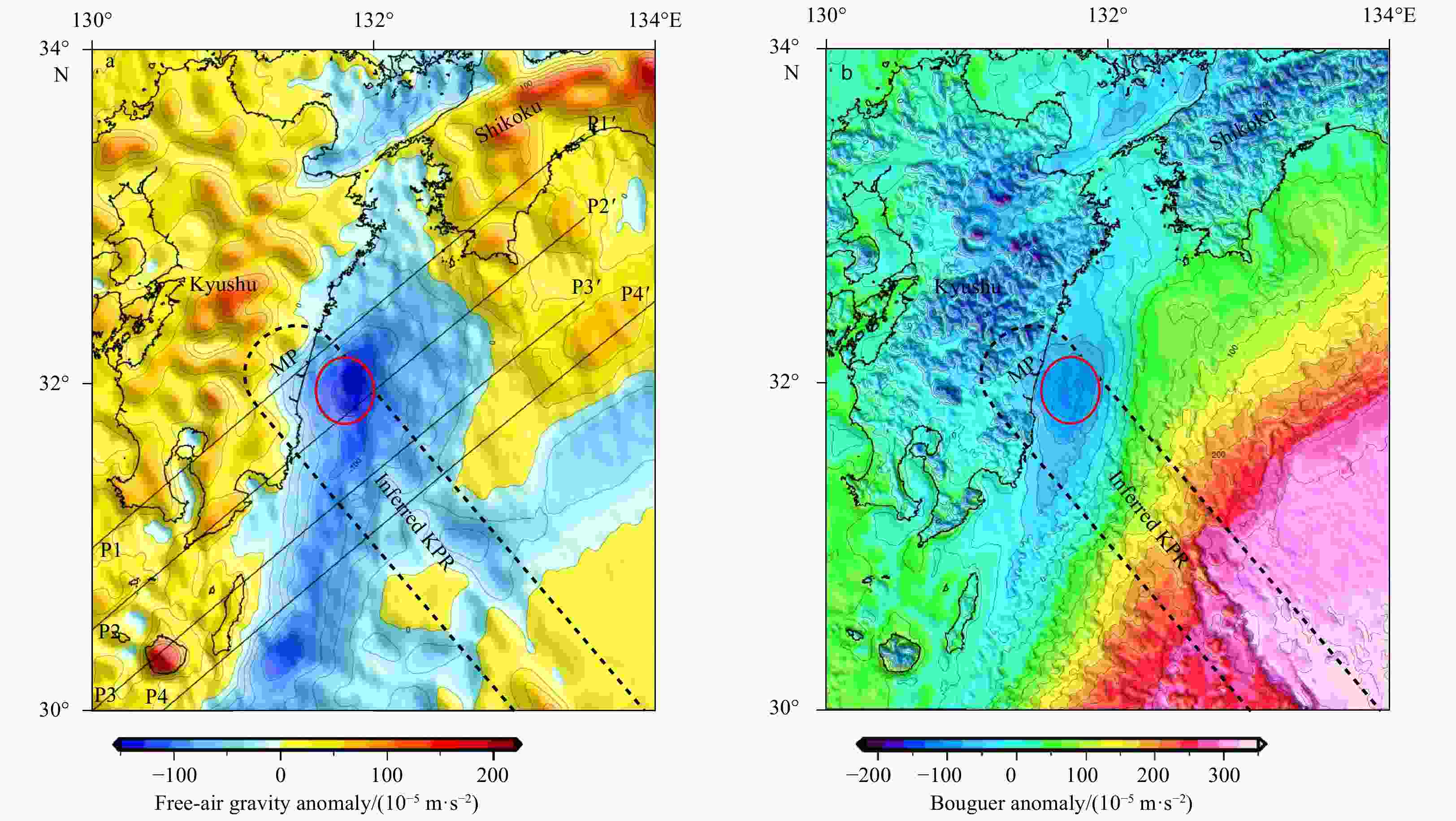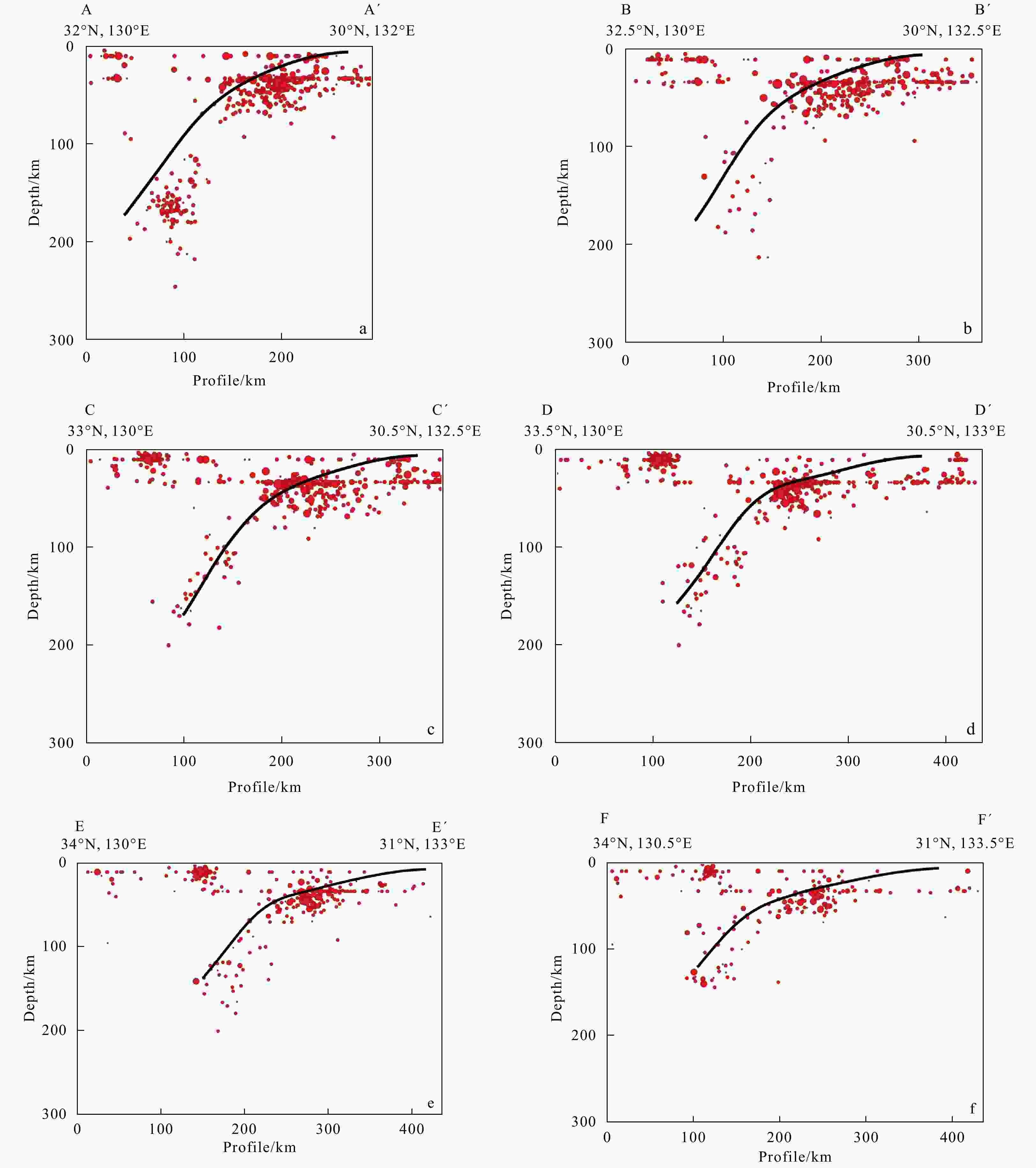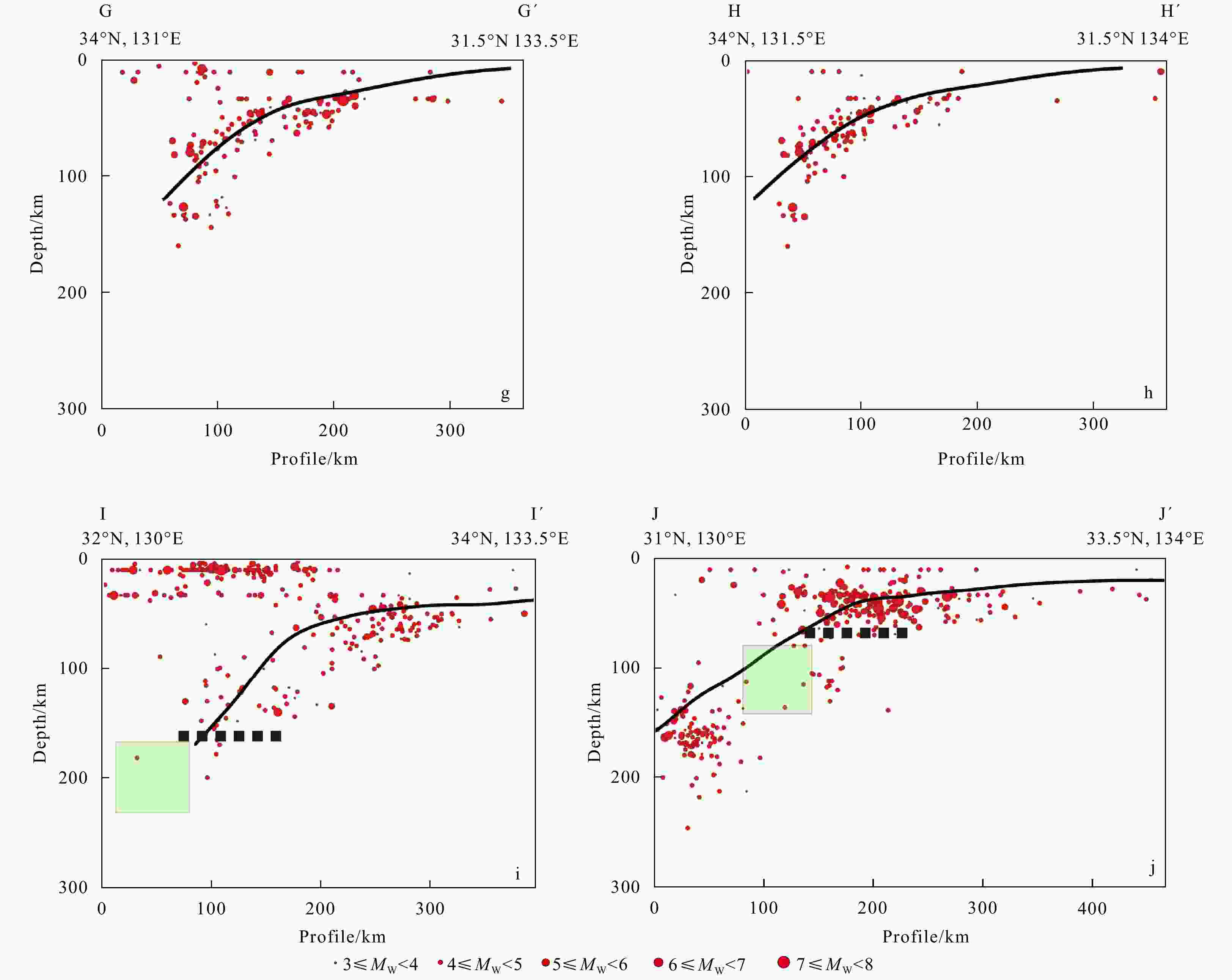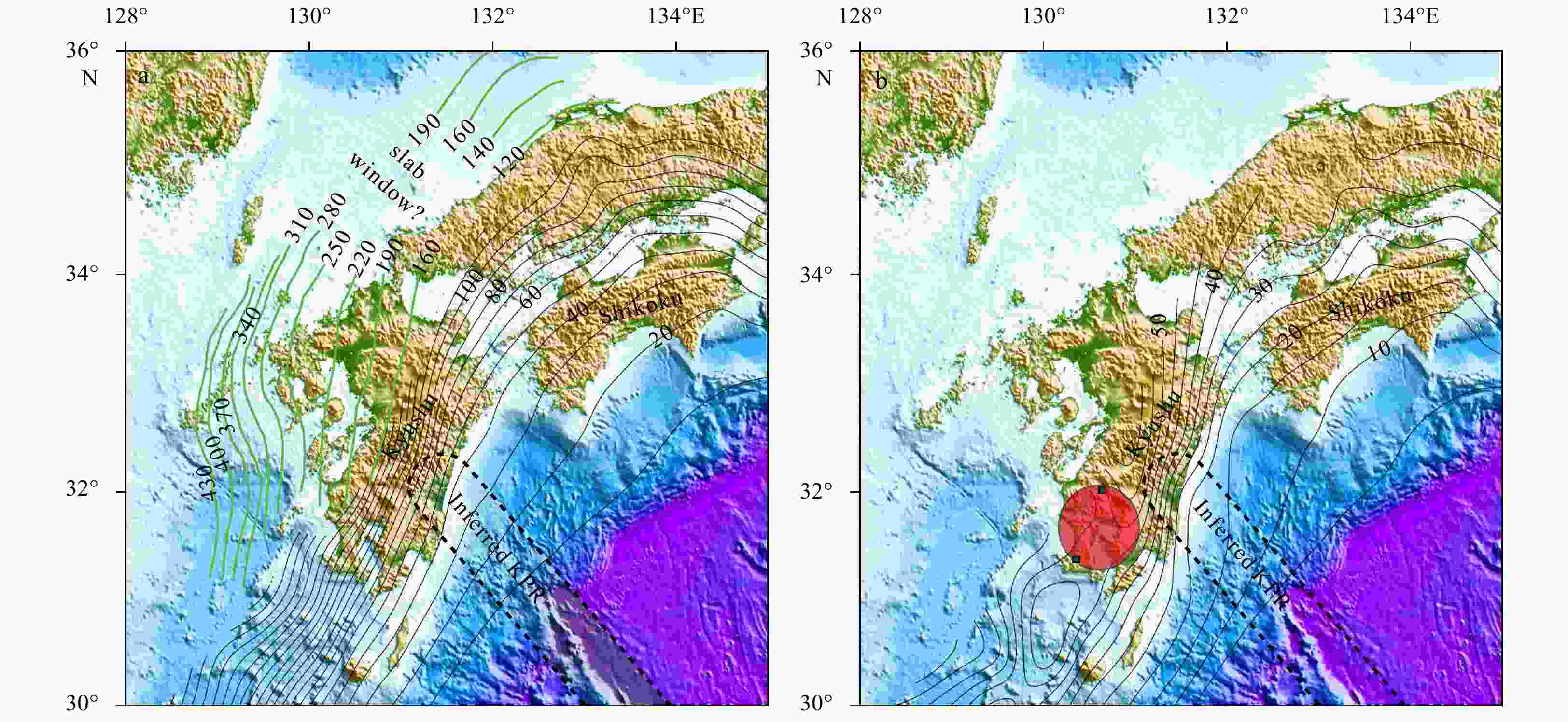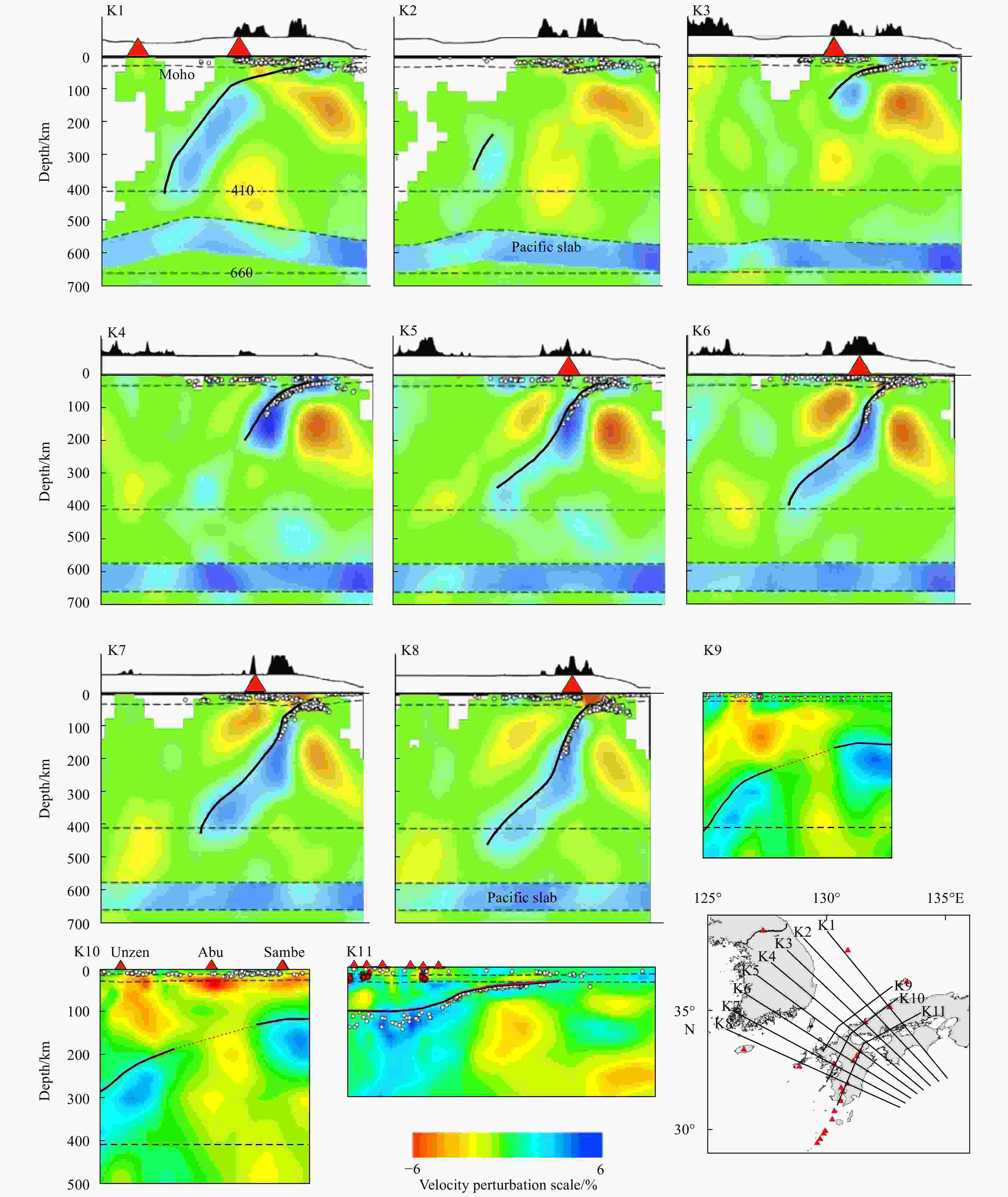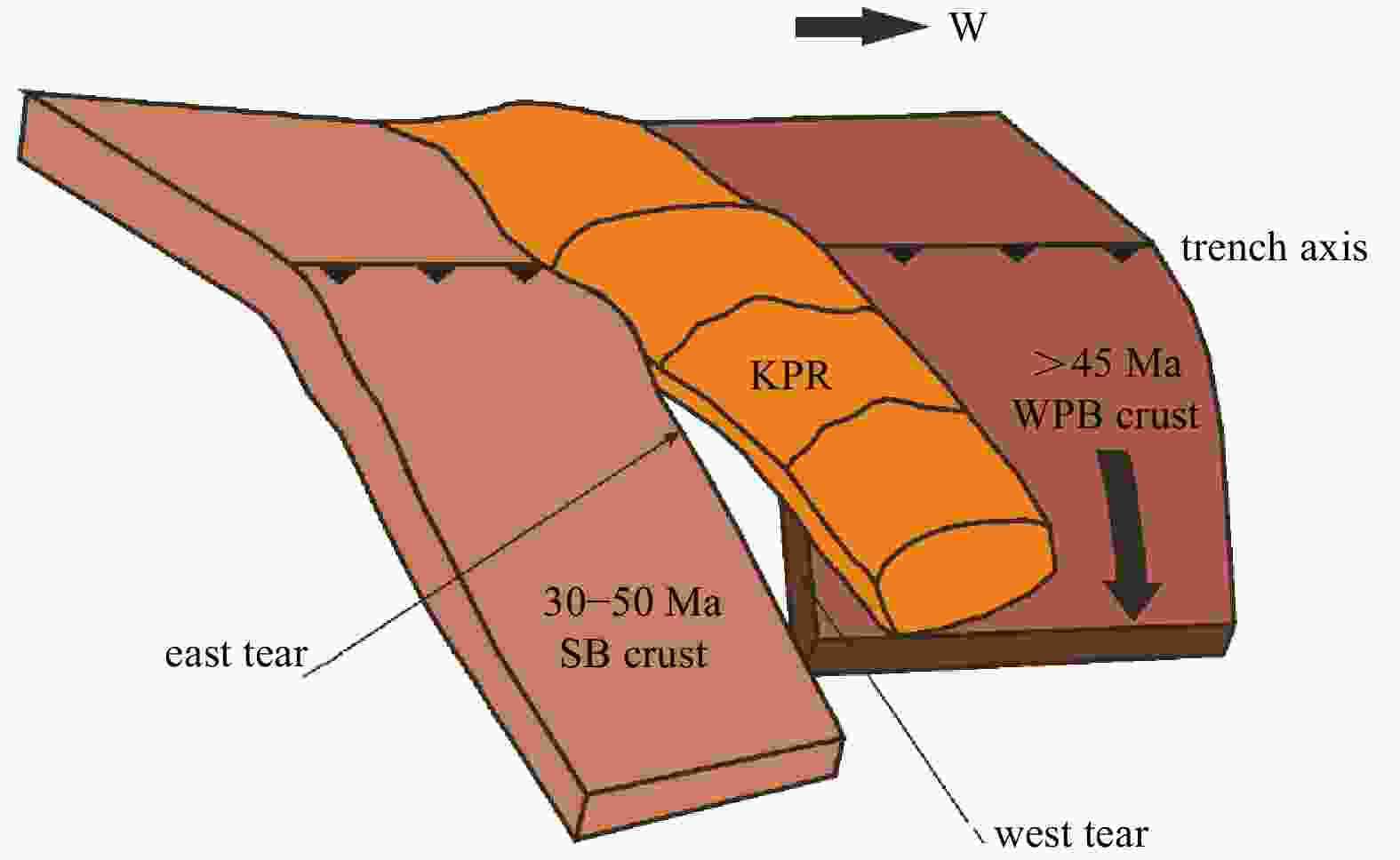Tectonic implications of the subduction of the Kyushu-Palau Ridge beneath the Kyushu, southwest Japan
-
Abstract: The Kyushu-Palau Ridge (KPR), a remnant arc on the Philippine Sea Plate (PSP), is subducting beneath the Kyushu, southwest Japan. Influenced by the subducting KPR, the Kyushu subduction zone corresponding to the KPR is significantly different from Shikoku subduction zone in terms of gravity anomalies, seismicity, the stress state, and the subducting slab morphology. Significant negative free-air and Bouguer gravity anomalies are observed in a prolonged area of KPR, southeast of the Miyazaki Plain, indicating that this is where KPR overlaps the overriding plate. The gravity anomaly in this area is much lower than that in other areas where the inferred KPR extends, suggesting that the subduction of the buoyant KPR may cause the lower mantle density to decrease. More earthquakes have occurred in Hyuga-nada region where the KPR subducts than in Shikoku forearc and other areas in the Kyushu forearc, indicating that the subduction of the KPR enhances the local coupling between the subducting and overriding plates. The centroid moment tensor (CMT) mechanism of earthquakes shows that stress is concentrated in the accumulated crust beneath the Kyushu forearc corresponding to the KPR, and the shallow thrusting events in the obducting plate are caused by the KPR subduction. The buoyant KPR, with a large volume of low-density sediments, was responsible for the differences of the subduction depth and dip angle of the subducting Philippine Sea (PS) slab between northern Kyushu and Shikoku. The seismic gaps and the sudden change of the dipping angle of the subducting PS slab indicate that slab tear may have occurred along the west side of the KPR beneath southwest Kyushu. A two-tear model was proposed, and the subduction of the buoyant KPR was believed to play an important role in the slab tear.
-
Key words:
- Kyushu-Palau Ridge /
- gravity anomaly /
- seismicity /
- slab morphology /
- slab tear
-
Figure 1. Overview of the plate tectonics of the southwestern Japan. The topography is from ETOPO1 (Amante and Eakins, 2009). The red triangles represent active volcanoes. Intermediate-magnitude (6≤MW≤7.5) earthquakes that have occurred in the Hyuga-nada region since the 1960s are marked with green stars. The yellow and blue dashed lines denote the active left-lateral shear zone and tectonic line, respectively. The black dashed line demarcates the inferred subducted KPR, and the red dotted line shows the location of the slab fracture (Park et al., 2009). The sawtooth curves represent the trenches. The solid and open circles denote uplifted marine terraces formed during the late Pleistocene and middle Holocene, respectively (Nakada et al., 2002). The altitudes of these terraces (m) are also shown. WPB: West Philippine Basin, SB: Shikoku Basin, PVB: Parece Vela Basin, KPR: Kyushu-Palau Ridge, OKTL: Oita-Kumamoto Tectonic Line, and MTL: Median Tectonic Line.
Figure 2. Free-air gravity anomaly map of the study area (a), and Bouguer anomaly map of the study area (b). The contours represent intervals of 25×10–5 m/s2. The red ellipses mark the maximum negative gravity anomalies off the Miyazaki Plain. Lines with capital letters (e.g., P1–P1′) are the positions of the geophysical sections shown in Fig. 7. MP: Miyazaki Plain.
Figure 3. Epicentral distribution of earthquakes (MW≥3) in different depth ranges for southwest Japan from 1960 to 2018. Earthquake epicenters were derived from the USGS Earthquake Hazards Program. Lines with capital letters (e.g., A–A′) are the positions of the seismicity profiles shown in Fig. 5. The light yellow ellipse denotes the seismic concentration zone in Hyuga-nada region.
Figure 4. GCMT solutions of earthquakes (MW≥4) during 1976–2017. The topography is from SRTM15+ (Tozer et al., 2019). The blue squares show hydrothermal deposits that may be related to the subduction of the KPR. The contours denote the bathymetry at 1000 m intervals. The size of the focal sphere is proportional to the magnitude of the earthquake, and the color of the compressed quadrant of each focal sphere denotes the depth of the hypocenter. The black dashed line marks the inferred KPR. The light grey ellipse denotes the seismic concentration zone. SB: Shikoku Basin, MP: Miyazaki Plain, MTL: Median Tectonic Line, and OKTL: Oita-Kumamoto Tectonic Line.
Figure 6. Morphology of the upper boundary of the subducting PS slab beneath southwest Japan. a. Depth of the upper boundary of the subducting PS slab. The green lines denote the upper boundary of the subducting PS slab estimated from the teleseismic tomography (Zhao et al., 2012). b. Subduction angles of the subducting PS slab. The light pink ellipse shows a sudden change in the subduction angle that may be related to the subduction of the KPR.
Figure 7. Comprehensive geophysical (Bouguer anomaly, free-air anomaly, and topography) sections perpendicular to the inferred KPR (see Fig. 2a for line location). The light yellow rectangles represent the location of the inferred KPR.
Figure 8. Vertical P-wave tomography cross-sections along the profiles shown on the inset map (modified from Huang et al., 2013; Cao et al., 2014). Red and blue colors denote lower and higher velocities, respectively. The velocity perturbation scale (%) is shown at the bottom. The red triangles denote active arc volcanoes. The red broken lines in K9 and K10 represent the discontinuity or gap in the high-velocity zone. The two dashed lines in each cross-section represent the 410 km and 660 km discontinuities. The white dots denote seismicity that occurred within a 20 km width of each profile.
Figure 9. 3-D view of the two-tear model for the subducting KPR. See Fig. 1 for abbreviations.
Table 1. List of the events and fault plane solutions obtained from the GCMT catalog
Event No. Date (d/m/y) Time (GMT) N lat/(°) E lon/(°) Depth/km MW Mb Ms Fault plane 1 strike/
dip/slip /(°)Fault plane 2 strike/
dip/slip /(°)1 14/4/2016 15:03 32.71 130.69 12.0 6.0 0.0 6.0 30/77/180 120/90/13 2 18/4/2016 11:42 33.00 131.12 13.2 5.5 0.0 5.5 44/79/–175 313/85/–11 3 19/4/2016 08:52 32.55 130.54 13.3 5.3 0.0 5.3 36/73/–177 305/87/–17 4 19/4/2016 11:47 32.62 130.56 16.1 4.9 0.0 4.8 21/77/179 112/89/13 5 5/5/2016 01:40 33.02 130.92 24.4 4.9 0.0 4.6 49/60/–179 318/89/–30 6 12/2/1994 17:07 32.03 130.33 15.0 5.4 4.7 5.3 179/89/–179 89/89/–1 7 26/3/1997 08:31 32.04 130.09 29.8 6.1 5.6 5.9 8/89/179 98/89/1 8 2/4/1997 19:33 31.82 130.17 15.0 5.4 5.1 5.0 2/70/166 97/77/20 9 13/5/1997 05:38 32.00 130.26 16.2 6.0 5.6 5.8 280/75/–14 14/77/–164 10 5/12/1983 01:53 32.29 131.64 31.5 5.4 5.0 5.5 340/9/–151 221/86/–82 11 6/8/1984 19.06 32.34 131.94 28.5 6.9 6.2 6.8 337/7/–136 203/85/–85 12 12/5/1985 10:41 32.83 132.52 38.9 5.5 5.7 5.2 0/33/–103 195/58/–82 13 18/3/1987 03:36 31.94 131.77 38.0 6.0 6.5 6.6 348/27/–103 182/64/–84 14 27/3/2006 02:50 32.70 132.02 22.2 5.5 5.3 5.7 315/5/–164 09/89/–85 15 5/8/2009 03:51 32.56 131.97 33.4 5.0 5.1 0.0 360/25/–90 180/65/–90 16 2/3/2017 14:53 32.69 131.82 48.7 5.2 0.0 5.3 334/25/–129 196/71/–74 17 30/6/1984 20:27 30.07 131.47 23.8 5.4 5.3 0.0 348/38/–107 189/54/–78 18 2/3/1985 08:45 30.54 132.15 17.9 5.3 5.3 5.1 6/32/–100 197/59/–84 19 27/9/1993 04:43 30.81 132.21 27.0 5.6 5.5 5.2 36/26/–55 177/69/–105 20 14/11/1995 17:08 31.48 133.10 28.8 5.0 5.1 4.2 199/45/–81 6/45/–99 21 16/7/2002 11:57 30.87 132.35 15.0 5.4 5.4 4.8 21/45/–70 173/48/–109 22 9/4/2011 12:57 30.04 131.84 12.2 6.0 6.1 6.0 358/36/–107 199/56/–78 23 13/2/2013 03:57 30.30 131.58 12.0 5.4 5.5 5.4 343/26/–134 211/72/–71 24 29/42017 12:32 30.82 131.43 25.9 5.8 0.0 5.7 355/30/–133 201/62/–77 25 18/12/2017 23.:28 30.78 131.76 12.0 5.1 0.0 5.2 39/14/–63 191/77/–97 26 20/12/2017 13:40 30.77 132.14 12.0 5.5 0.0 5.5 352/42/–119 209/54/–66 27 21/12/2017 03:40 30.85 131.90 12.0 5.0 0.0 5.1 17/20/–98 205/70/–87 28 19/10/1996 08:31 31.82 131.89 38.8 5.5 5.4 5.0 94/22/67 38/69/99 29 2/12/1996 22:18 31.76 131.72 33.4 6.7 6.0 6.6 206/19/80 37/71/94 30 16/12/1998 00:18 31.17 131.54 27.0 6.0 5.5 5.6 198/13/63 46/78/96 31 31/5/2005 02:04 31.35 131.69 38.0 5.7 5.5 5.3 188/32/67 34/61/103 32 5/4/2009 09:36 31.78 132.06 33.5 5.8 5.8 5.8 209/24/89 31/66/91 33 11/3/2013 09:34 31.57 131.92 28.7 5.4 5.2 0.0 186/29/70 29/63/101 34 18/7/2015 17:13 31.16 131.64 34.7 4.8 0.0 4.7 187/35/67 34/58/05 35 16/5/2016 08:50 31.69 132.08 35.9 4.9 0.0 4.8 220/32/97 32/58/86 36 5/7/1982 08:57 30.77 130.47 119.0 5.5 5.7 0.0 304/10/173 41/89/80 37 23/9/1992 13:38 31.14 130.16 168.5 5.7 5.8 0.0 261/24/160 9/82/68 38 21/11/2005 15:36 30.97 130.31 155.0 6.2 5.9 0.0 253/17/159 4/84/75 39 3/9/2009 13:26 31.08 130.19 168.4 6.2 5.9 6.2 241/23/131 18/73/74 40 25/7/2012 17:20 31.05 130.37 137.6 5.0 5.0 0.0 247/38/168 347/82/52 41 16/10/2012 13: 39 31.27 130.29 182.1 5.2 5.3 0.0 212/18/116 5/74/82 42 11/3/2013 05: 35 31.21 130.40 175.7 5.0 4.7 0.0 245/14/148 6/83/78 -
[1] Abe Y, Ohkura T, Hirahara K, et al. 2011. Water transportation through the Philippine Sea slab subducting beneath the central Kyushu region, Japan, as derived from receiver function analyses. Geophysical Research Letters, 38(23): L23305 [2] Abe Y, Ohkura T, Hirahara K, et al. 2013. Along-arc variation in water distribution in the uppermost mantle beneath Kyushu, Japan, as derived from receiver function analyses. Journal of Geophysical Research: Solid Earth, 118(7): 3540–3556. doi: 10.1002/jgrb.50257 [3] Amante C, Eakins B W. 2009. ETOPO1 1 arc-minute global relief model: procedures, data sources and analysis. NOAA Technical Memorandum NESDIS NGDC-24. National Geophysical Data Center, NOAA [4] Bautista B C, Bautista M L P, Oike K, et al. 2001. A new insight on the geometry of subducting slabs in northern Luzon, Philippines. Tectonophysics, 339(3–4): 279–310 [5] Bourdon E, Eissen J P, Monzier M, et al. 2002. Adakite-like lavas from Antisana volcano (Ecuador): Evidence for slab melt metasomatism beneath Andean northern volcanic zone. Journal of Petrology, 43(2): 199–217. doi: 10.1093/petrology/43.2.199 [6] Cao Lingmin, Wang Zhi, Wu Shiguo, et al. 2014. A new model of slab tear of the subducting Philippine Sea Plate associated with Kyushu-Palau Ridge subduction. Tectonophysics, 636: 158–169. doi: 10.1016/j.tecto.2014.08.012 [7] Castle J C, Creager K C. 1998. Topography of the 660-km seismic discontinuity beneath Izu-Bonin: Implications for tectonic history and slab deformation. Journal of Geophysical Research: Solid Earth, 103(B6): 12511–12527. doi: 10.1029/98JB00503 [8] Castle J C, Creager K C. 1999. A steeply dipping discontinuity in the lower mantle beneath Izu-Bonin. Journal of Geophysical Research: Solid Earth, 104(B4): 7279–7292. doi: 10.1029/1999JB900011 [9] Chen Yuxiao, Xia Xiaohong, Song Shuguang. 2012. Petrogenesis of Aoyougou high-silica adakite in the North Qilian orogen, NW China: evidence for decompression melting of oceanic slab. Chinese Science Bulletin, 57(18): 2289–2301. doi: 10.1007/s11434-012-5069-3 [10] Chen Ping, Zheng Yanpeng, Liu Baohua. 2014. Geophysical features of the Nankai Trough subduction zone and their dynamic significance. Marine Geology & Quaternary Geology (in Chinese), 34(6): 153–160 [11] Cooke D R, Hollings P, Walshe J L. 2005. Giant porphyry deposits: characteristics, distribution, and tectonic controls. Economic Geology, 100(5): 801–818. doi: 10.2113/gsecongeo.100.5.801 [12] Cooke D R, Simmons S F. 2000. Characteristics and genesis of epithermal gold deposits. Reviews in Economic Geology, 13: 221–244 [13] Cosca M, Arculus R J, Pearce J, et al. 1998. 40Ar/39Ar and K–Ar geochronological age constraints for the inception and early evolution of the Izu-Bonin-Mariana arc system. Island Arc, 7(3): 579–595. doi: 10.1111/j.1440-1738.1998.00211.x [14] Das S, Watts A B. 2009. Effect of subducting seafloor topography on the rupture characteristics of great subduction zone earthquakes. In: Lallemand S, Funiciello F, eds. Subduction Zone Geodynamics. Berlin, Heidelberg: Springer, 103–108 [15] Defant M J, Drummond M S. 1990. Derivation of some modern arc magmas by melting of young subducted lithosphere. Nature, 347(6294): 662–665. doi: 10.1038/347662a0 [16] Defant M J, Jackson T E, Drummond M S, et al. 1992. The geochemistry of young volcanism throughout western Panama and southeastern Costa Rica: An overview. Journal of the Geological Society, 149(4): 569–579. doi: 10.1144/gsjgs.149.4.0569 [17] Defant M J, Sherman S, Maury R C, et al. 2001. The geology, petrology, and petrogenesis of Saba Island, Lesser Antilles. Journal of Volcanology and Geothermal Research, 107(1–3): 87–111 [18] DeMets C, Gordon R G, Argus D F. 2010. Geologically current plate motions. Geophysical Journal International, 181(1): 1–80. doi: 10.1111/j.1365-246X.2009.04491.x [19] Deschamps A, Lallemand S. 2002. The West Philippine Basin: An Eocene to early Oligocene back arc basin opened between two opposed subduction zones. Journal of Geophysical Research: Solid Earth, 107(B12): EPM 1-1–EPM 1-24. doi: 10.1029/2001JB001706 [20] Dziewonski A M, Chou T A, Woodhouse J H, et al. 1981. Determination of earthquake source parameters from waveform data for studies of global and regional seismicity. Journal of Geophysical Research: Solid Earth, 86(B4): 2825–2585. doi: 10.1029/JB086iB04p02825 [21] Ekström G, Nettles M, Dziewoński A M. 2012. The global CMT project 2004–2010: Centroid-moment tensors for 13,017 earthquakes. Physics of the Earth and Planetary Interiors, 200–201: 1–9 [22] Ely K S, Sandiford M. 2010. Seismic response to slab rupture and variation in lithospheric structure beneath the Savu Sea, Indonesia. Tectonophysics, 483(1–2): 112–124 [23] Falloon T J, Danyushevsky L V, Crawford A J, et al. 2008. Boninites and adakites from the northern termination of the Tonga trench: Implications for Adakite Petrogenesis. Journal of Petrology, 49(4): 697–715 [24] Fan Jianke, Wu Shiguo, Spence G. 2015. Tomographic evidence for a slab tear induced by fossil ridge subduction at Manila Trench, South China Sea. International Geology Review, 57(5–8): 998–1013 [25] Fan Jianke, Zhao Dapeng, Dong Dongdong. 2016. Subduction of a buoyant plateau at the Manila Trench: Tomographic evidence and geodynamic implications. Geochemistry, Geophysics, Geosystems, 17(2): 571–586. doi: 10.1002/2015GC006201 [26] Gurnis M, Hall C, Lavier L. 2004. Evolving force balance during incipient subduction. Geochemistry, Geophysics, Geosystems, 5(7): Q07001 [27] Gutscher M A, Malavieille J, Lallemand S, et al. 1999. Tectonic segmentation of the North Andean margin: Impact of the Carnegie Ridge collision. Earth and Planetary Science Letters, 168(3–4): 255–270 [28] Gutscher M A, Maury R, Eissen J P, et al. 2000. Can slab melting be caused by flat subduction?. Geology, 28(6): 535–538. doi: 10.1130/0091-7613(2000)28<535:CSMBCB>2.0.CO;2 [29] Hall R. 2002. Cenozoic geological and plate tectonic evolution of SE Asia and the SW Pacific: Computer-based reconstructions, model and animations. Journal of Asian Earth Sciences, 20(4): 353–431. doi: 10.1016/S1367-9120(01)00069-4 [30] Hall R, Ali J R, Anderson C D. 1995a. Cenozoic motion of the Philippine Sea Plate: palaeomagnetic evidence from eastern Indonesia. Tectonics, 14(5): 1117–1132. doi: 10.1029/95TC01694 [31] Hall R, Ali J R, Anderson C D, et al. 1995b. Origin and motion history of the Philippine Sea Plate. Tectonophysics, 251(1–4): 229–250 [32] Hall R, Fuller M, Ali J R, et al. 1995c. The Philippine Sea Plate: Magnetism and reconstructions. In: Taylor B, Natland J, eds. Active Margins and Marginal Basins of the Western Pacific. Washington, D C: American Geophysical Union, 371–403 [33] Hall C E, Gurnis M, Sdrolias M, et al. 2003. Catastrophic initiation of subduction following forced convergence across fracture zones. Earth and Planetary Science Letters, 212(1–2): 15–30 [34] Haraguchi S, Ishii T, Kimura J I, et al. 2003. Formation of tonalite from basaltic magma at the Komahashi-Daini Seamount, northern Kyushu-Palau Ridge in the Philippine Sea, and growth of Izu-Ogasawara (Bonin)-Mariana arc crust. Contributions to Mineralogy and Petrology, 145(2): 151–168. doi: 10.1007/s00410-002-0433-y [35] Hayes G P, Wald D J, Johnson R L. 2012. Slab1.0: A three-dimensional model of global subduction zone geometries. Journal of Geophysical Research, 117(B1): B01302 [36] Hedenquist J W, Matsuhisa Y, Izawa E, et al. 1994. Geology, geochemistry, and origin of high sulfidation Cu-Au mineralization in the Nansatsu District, Japan. Economic Geology, 89(1): 1–30. doi: 10.2113/gsecongeo.89.1.1 [37] Huang Zhouchuan, Zhao Dapeng, Hasegawa A, et al. 2013. Aseismic deep subduction of the Philippine Sea plate and slab window. Journal of Asian Earth Sciences, 75: 82–94. doi: 10.1016/j.jseaes.2013.07.002 [38] Ichikawa G. 1997. Ocean bottom seismographic experiment to study crustal structure in Hyuga-nada [dissertation]. Sapporo: University of Hokkaido (in Japanese) [39] Ishihara T, Koda K. 2007. Variation of crustal thickness in the Philippine Sea deduced from three-dimensional gravity modeling. Island Arc, 16(3): 322–337. doi: 10.1111/j.1440-1738.2007.00593.x [40] Ishizuka O, Taylor R N, Yuasa M, et al. 2011. Making and breaking an island arc: A new perspective from the Oligocene Kyushu-Palau arc, Philippine Sea. Geochemistry, Geophysics, Geosystems, 12(5): Q05005 [41] Izawa E, Urashima Y, Ibaraki K, et al. 1990. The Hishikari gold deposit: High-grade epithermal veins in Quaternary volcanics of southern Kyushu, Japan. Journal of Geochemical Exploration, 36(1–3): 1–56 [42] Kakubuchi S, Nagao T, Nagao K. 2000. K-Ar ages and magmatic history of the Abu Monogenetic Volcano Group, southwest Japan. Japanese Magazine of Mineralogical and Petrological Sciences (in Japanese), 29(5): 191–198. doi: 10.2465/gkk.29.191 [43] Karig D E. 1972. Remnant arcs. GSA Bulletin, 83(4): 1057–1068. doi: 10.1130/0016-7606(1972)83[1057:RA]2.0.CO;2 [44] Karig D E, Ingle J C Jr. 1975. Initial Reports of the Deep Sea Drilling Project. Washington, US: Government Printing Office, 191–274 [45] Kelleher J, McCann W. 1976. Buoyant zones, great earthquakes, and unstable boundaries of subduction. Journal of Geophysical Research, 81(26): 4885–4896. doi: 10.1029/JB081i026p04885 [46] Kepezhinskas P, Defant M J, Drummond M S. 1996. Progressive enrichment of island arc mantle by melt-peridotite interaction inferred from Kamchatka xenoliths. Geochimica et Cosmochimica Acta, 60(7): 1217–1229. doi: 10.1016/0016-7037(96)00001-4 [47] Kepezhinskas P, McDermott F, Defant M J, et al. 1997. Trace element and Sr-Nd-Pb isotopic constraints on a three-component model of Kamchatka Arc petrogenesis. Geochimica et Cosmochimica Acta, 61(3): 577–600. doi: 10.1016/S0016-7037(96)00349-3 [48] Kimura G. 1996. Collision orogeny at arc-arc junctions in the Japanese islands. Island Arc, 5(3): 262–275. doi: 10.1111/j.1440-1738.1996.tb00031.x [49] Kimura J I, Kunikiyo T, Osaka I, et al. 2003. Late Cenozoic volcanic activity in the Chugoku area, southwest Japan arc during back-arc basin opening and reinitiation of subduction. Island Arc, 12(1): 22–45. doi: 10.1046/j.1440-1738.2003.00377.x [50] Kodama K, Tashiro H, Takeuchi T. 1995. Quaternary counterclockwise rotation of south Kyushu, southwest Japan. Geology, 23(9): 823–826. doi: 10.1130/0091-7613(1995)023<0823:QCROSK>2.3.CO;2 [51] Kong Xiangchao, Li Sanzhong, Wang Yongming, et al. 2017. Triggering causes of earthquakes along the Izu-Bonin-Mariana subduction zone. Marine Geology & Quaternary Geology (in Chinese), 37(4): 83–97 [52] Kong Xiangchao, Li Sanzhong, Wang Yongming, et al. 2018. Causes of earthquake spatial distribution beneath the Izu-Bonin-Mariana Arc. Journal of Asian Earth Sciences, 151: 90–100. doi: 10.1016/j.jseaes.2017.10.015 [53] Lallemand S. 2016. Philippine Sea Plate inception, evolution, and consumption with special emphasis on the early stages of Izu-Bonin-Mariana subduction. Progress in Earth and Planetary Science, 3(1): 15. doi: 10.1186/s40645-016-0085-6 [54] Mahony S H, Wallace L M, Miyoshi M, et al. 2011. Volcano-tectonic interactions during rapid plate-boundary evolution in the Kyushu region, SW Japan. GSA Bulletin, 123(11–12): 2201–2223 [55] Mason W G, Moresi L, Betts P G, et al. 2010. Three-dimensional numerical models of the influence of a buoyant oceanic plateau on subduction zones. Tectonophysics, 483(1–2): 71–79 [56] Miller M S, Kennett B L N, Lister G S. 2004. Imaging changes in morphology, geometry, and physical properties of the subducting Pacific plate along the Izu-Bonin-Mariana arc. Earth and Planetary Science Letters, 224(3–4): 363–370 [57] Morris P A. 1995. Slab melting as an explanation of Quaternary volcanism and aseismicity in southwest Japan. Geology, 23(5): 395–398. doi: 10.1130/0091-7613(1995)023<0395:SMAAEO>2.3.CO;2 [58] Mungall J E. 2002. Roasting the mantle: slab melting and the genesis of major Au and Au-rich Cu deposits. Geology, 30(10): 915–918. doi: 10.1130/0091-7613(2002)030<0915:RTMSMA>2.0.CO;2 [59] Nagaoka S. 1986. The landform evolution of Late Pleistocene in the Miyazaki Plain, South Kyushu, Japan. The Quaternary Research, 25(3): 139–163. doi: 10.4116/jaqua.25.139 [60] Nakada M, Tahara M, Shimizu H, et al. 2002. Late Pleistocene crustal uplift and gravity anomaly in the eastern part of Kyushu, Japan, and its geophysical implications. Tectonophysics, 351(4): 263–283. doi: 10.1016/S0040-1951(02)00161-0 [61] Nishimura S, Ando M, Miyazaki S. 1999. Inter-plate coupling along the Nankai Trough and southeastward motion along southern part of Kyushu. Zisin (Journal of the Seismological Society of Japan. 2nd ser.), 51(4): 443–456. doi: 10.4294/zisin1948.51.4_443 [62] Nishizawa A, Kaneda K, Katagiri Y, et al. 2007. Variation in crustal structure along the Kyushu-Palau Ridge at 15–21°N on the Philippine Sea plate based on seismic refraction profiles. Earth, Planets and Space, 59(6): e17–e20. doi: 10.1186/BF03352711 [63] Nishizawa A, Kaneda K, Oikawa M. 2009. Seismic structure of the northern end of the Ryukyu Trench subduction zone, southeast of Kyushu, Japan. Earth, Planets and Space, 61(8): e37–e40. doi: 10.1186/BF03352942 [64] Oda H, Ushio T. 2007. Topography of the Moho and Conrad discontinuities in the Kyushu district, Southwest Japan. Journal of Seismology, 11(2): 221–233. doi: 10.1007/s10950-007-9049-z [65] Okino K, Ohara Y, Kasuga S, et al. 1999. The Philippine Sea: new survey results reveal the structure and the history of the marginal basins. Geophysical Research Letters, 26(15): 2287–2290. doi: 10.1029/1999GL900537 [66] Okino K, Shimakawa Y, Nagaoka S. 1994. Evolution of the Shikoku Basin. Journal of Geomagnetism & Geoelectricity, 46(6): 463–479 [67] Oyarzun R, Márquez A, Lillo J, et al. 2001. Giant versus small porphyry copper deposits of Cenozoic age in northern Chile: Adakitic versus normal calc-alkaline magmatism. Mineralium Deposita, 36(8): 794–798. doi: 10.1007/s001260100205 [68] Park J O, Hori T, Kaneda Y. 2009. Seismotectonic implications of the Kyushu-Palau ridge subducting beneath the westernmost Nankai forearc. Earth, Planets and Space, 61(8): 1013–1018. doi: 10.1186/BF03352951 [69] Peacock S M, Rushmer T, Thompson A B. 1994. Partial melting of subducting oceanic crust. Earth and Planetary Science Letters, 121(1–2): 227–244 [70] Reagan M K, Gill J B. 1989. Coexisting calcalkaline and high-niobium basalts from turrialba volcano, Costa Rica: Implications for residual titanates in arc magma sources. Journal of Geophysical Research, 94(B4): 4619–4633. doi: 10.1029/JB094iB04p04619 [71] Sadeghi H, Suzuki S, Takenaka H. 2000. Tomographic low-velocity anomalies in the uppermost mantle around the northeastern edge of Okinawa trough, the backarc of Kyushu. Geophysical Research Letters, 27(2): 277–280. doi: 10.1029/1999GL008385 [72] Sajona F G, Maury R C. 1998. Association of adakites with gold and copper mineralization in the philippines. Comptes Rendus De L’Académie Des Sciences-Series IIA-Earth and Planetary Science, 326(1): 27–34 [73] Sajona F G, Maury R C, Bellon H, et al. 1993. Initiation of subduction and the generation of slab melts in western and eastern Mindanao, Philippines. Geology, 21(11): 1007–1010. doi: 10.1130/0091-7613(1993)021<1007:IOSATG>2.3.CO;2 [74] Sandwell D T, Müller R D, Smith W H F, et al. 2014. New global marine gravity model from CryoSat-2 and Jason-1 reveals buried tectonic structure. Science, 346(6205): 65–67. doi: 10.1126/science.1258213 [75] Scholz C H, Small C. 1997. The effect of seamount subduction on seismic coupling. Geology, 25(6): 487–490. doi: 10.1130/0091-7613(1997)025<0487:TEOSSO>2.3.CO;2 [76] Sdrolias M, Roest W R, Müller R D. 2004. An expression of Philippine Sea plate rotation: The Parece Vela and Shikoku basins. Tectonophysics, 394(1–2): 69–86 [77] Sella G F, Dixon T H, Mao Ailin. 2002. REVEL: A model for recent plate velocities from space geodesy. Journal of Geophysical Research: Solid Earth, 107(B4): ETG 11-1–ETG 11-30. doi: 10.1029/2000JB000033 [78] Seno T, Maruyama S. 1984. Paleogeographic reconstruction and origin of the Philippine Sea. Tectonophysics, 102(1–4): 53–84 [79] Shi Xuejian. 1998. Spatial differences of the earthquake distribution along the island-arcs in the western Pacific and their causes. Seismology and Geology (in Chinese), 20(4): 399–404 [80] Shimoyama S, Kinoshita H, Miyahara M, et al. 1999. Mode of vertical crustal movements during the late quaternary in Kyushu, Japan, deduced from heights of ancient shorelines. Tectonophysics, 302(1–2): 9–22 [81] Smith W H F, Sandwell D T. 1997. Global sea floor topography from satellite altimetry and ship depth soundings. Science, 277(5334): 1956–1962. doi: 10.1126/science.277.5334.1956 [82] Sugimoto T, Shibata T, Yoshikawa M, et al. 2006. Sr-Nd-Pb isotopic and major and trace element compositions of the Yufu-Tsurumi volcanic rocks: implications for the magma genesis of the Yufu-Tsurumi volcanoes, northeast Kyushu, Japan. Journal of Mineralogical and Petrological Sciences, 101(5): 270–275. doi: 10.2465/jmps.101.270 [83] Sun Weidong, Ling Mingxing, Yang Xiaoyong, et al. 2010. Ridge subduction and porphyry copper-gold mineralization: An overview. Science China Earth Sciences, 53(4): 475–484. doi: 10.1007/s11430-010-0024-0 [84] Sun Weidong, Zhang Hong, Ling Mingxing, et al. 2011. The genetic association of adakites and Cu-Au ore deposits. International Geology Review, 53(5–6): 691–703 [85] Tahara M, Uehira K, Shimizu H, et al. 2008. Seismic velocity structure around the Hyuganada region, Southwest Japan, derived from seismic tomography using land and OBS data and its implications for interplate coupling and vertical crustal uplift. Physics of the Earth and Planetary Interiors, 167(1–2): 19–33 [86] Thiéblemont D, Stein G, Lescuyer J L. 1997. Epithermal and porphyry deposits: The adakite connection. Comptes Rendus De L’Académie Des Sciences Series IIA Earth and Planetary Science, 325(2): 103–109 [87] Tozer B, Sandwell D T, Smith W H F, et al. 2019. Global bathymetry and topography at 15 arc sec: SRTM15+. Earth and Space Science, 6(10): 1847–1864. doi: 10.1029/2019EA000658 [88] Wang Kelin, Wada I, Ishikawa Y. 2004. Stresses in the subducting slab beneath southwest Japan and relation with plate geometry, tectonic forces, slab dehydration, and damaging earthquakes. Journal of Geophysical Research: Solid Earth, 109(B8): B08304 [89] Watts A B, Koppers A A P, Robinson D P. 2010. Seamount subduction and earthquakes. Oceanography, 23(1): 166–173. doi: 10.5670/oceanog.2010.68 [90] Wessel P, Smith W H F, Scharroo R, et al. 2013. Generic mapping tools: improved version released. Eos, Transactions American Geophysical Union, 94(45): 409–410 [91] Xia Shaohong, Sun Jinlong, Huang Haibo. 2015. Degree of serpentinization in the forearc mantle wedge of Kyushu subduction zone: Quantitative evaluations from seismic velocity. Marine Geophysical Research, 36(2–3): 101–112 [92] Xia Chenglong, Zheng Yanpeng, Dong Dongdong, et al. 2017. Characteristics of magnetic lineations and reconstruction of seafloor spreading processes of the Philippine Sea Basin since 61 Ma. Marine Geology and Quaternary Geology (in Chinese), 37(1): 30–40 [93] Xia Shaohong, Zhao Dapeng, Qiu Xuelin. 2008. Tomographic evidence for the subducting oceanic crust and forearc mantle serpentinization under Kyushu, Japan. Tectonophysics, 449(1–4): 85–96 [94] Yamamoto Y, Obana K, Takahashi T, et al. 2014. Seismicity and structural heterogeneities around the western Nankai Trough subduction zone, southwestern Japan. Earth and Planetary Science Letters, 396: 34–45. doi: 10.1016/j.jpgl.2014.04.006 [95] Yan Quanshu, Shi Xuefa. 2011. Geological comparative studies of Japan arc system and Kyushu-Palau arc. Acta Oceanologica Sinica, 30(4): 107–121. doi: 10.1007/s13131-011-0134-3 [96] Yan Quanshu, Shi Xuefa. 2014. Geological effects of aseismic ridges or seamount chains subduction on the supra-subduction zone. Haiyang Xuebao (in Chinese), 36(5): 107–123 [97] Yogodzinski G M, Lees J M, Churikova T G, et al. 2001. Geochemical evidence for the melting of subducting oceanic lithosphere at plate edges. Nature, 409(6819): 500–504. doi: 10.1038/35054039 [98] Zang Shaoxian, Ning Jieyuan. 1996. Study on the subduction zone in western pacific and its implication for the geodynamics. Acta Geophysica Sinica (in Chinese), 39(2): 188–202 [99] Zhang Jie, Li Jiabiao, Ding Weiwei. 2012. Reviews of the study on crustal structure and evolution of the Kyushu-Palau ridge. Advances in Marine Science (in Chinese), 30(4): 595–607 [100] Zhao Dapeng, Asamori K, Iwamori H. 2000. Seismic structure and magmatism of the young Kyushu subduction zone. Geophysical Research Letters, 27(14): 2057–2060. doi: 10.1029/2000GL011512 [101] Zhao Dapeng, Yanada T, Hasegawa A, et al. 2012. Imaging the subducting slabs and mantle upwelling under the Japan islands. Geophysical Journal International, 190(2): 816–828. doi: 10.1111/j.1365-246X.2012.05550.x -





 下载:
下载:
